Exotic, but established
Acleris forsskaleana (L.) (Tortricidae: Tortricinae: Tortricini)
Common names: maple leaftier moth, hairnet Acleris, maple button
Synonyms: agraphana (Tortrix), folskaleana (Tortrix), forcaleana (Tortrix), forscaeleana (Tortrix), forskaeleana (Tortrix), forskahleana (Pyralis), forskahliana (Pyralis), forskaleana (Phalaena), forskaleana (Rhacodia), forskaliana (Tortrix), forskoleana (Tortrix), forskoliana (Tortrix)
FWLFWL:
forewing length; the distance from the base of the forewing to the apex, including fringe : 6.0-8.0 mm
: 6.0-8.0 mm
Head pale yellow; thorax pale yellow, occasionally with orange transverse line; forewing with ground color pale yellow with fine network of orange or red-orange reticulationsreticulations:
covered with a network of lines or mesh; in reference to wing pattern, usually thin horizontal lines 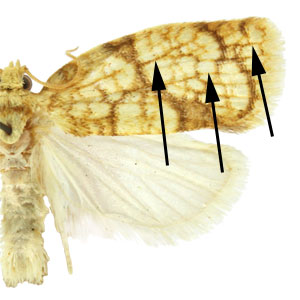 , small brown or black scale tufts present near midpoint of inner margininner margin:
, small brown or black scale tufts present near midpoint of inner margininner margin:
see dorsum 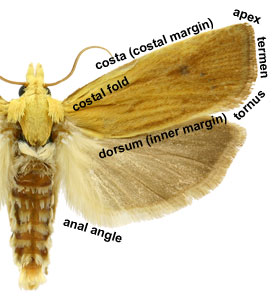 , variably expressed gray or brown suffusion occupying much of middle of forewing; termentermen:
, variably expressed gray or brown suffusion occupying much of middle of forewing; termentermen:
the outer edge of the forewing 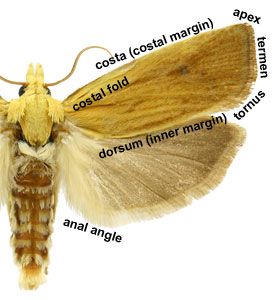 with conspicuous red-orange or brown line; male without forewing costal foldforewing costal fold:
with conspicuous red-orange or brown line; male without forewing costal foldforewing costal fold:
a flap or fold at the base of the forewing that contains specialized sex scales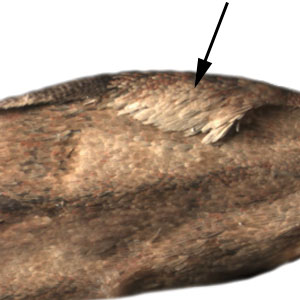 ; hindwing yellow to pale brown.
; hindwing yellow to pale brown.
Male genitalia are characterized by uncusuncus:
a sclerotized process which is fused to the posterodorsal margin of tergum IX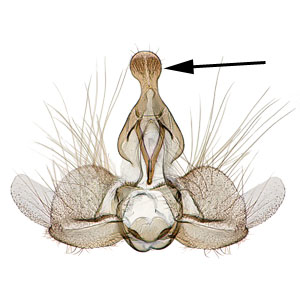 absent; sociisocii:
absent; sociisocii:
a pair of lightly sclerotized setose lobes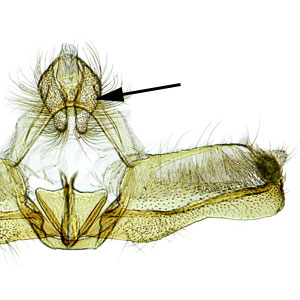 , broad, well-developed; valvaevalva:
, broad, well-developed; valvaevalva:
an appendage flanking the intromittent organ that is used to clasp the female during copulation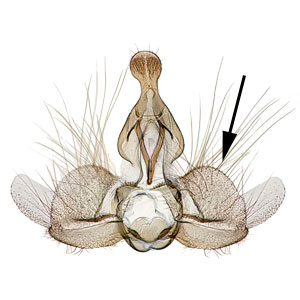 trapezoidal with a well-developed sacculussacculus:
trapezoidal with a well-developed sacculussacculus:
the ventral margin of the male valva 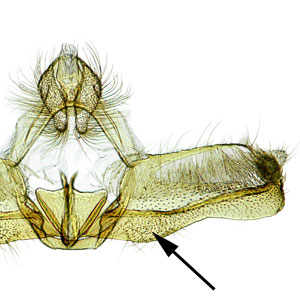 and weakly developed brachiola. The female genitalia are characterized by relatively large papillae analespapillae anales:
and weakly developed brachiola. The female genitalia are characterized by relatively large papillae analespapillae anales:
the female ovipositor lobes 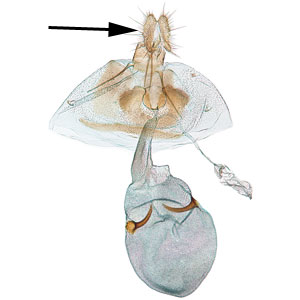 ; short apophysesapophyses:
; short apophysesapophyses:
apodemal rods used to extend the ovipositor; divided into the apophyses anteriores and apophyses posteriores 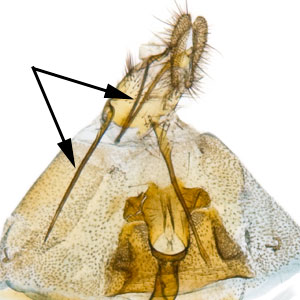 ; a well-sclerotized colliculum, and a single, stellate signasignum:
; a well-sclerotized colliculum, and a single, stellate signasignum:
a sclerotized projection or patch on the interior of the corpus bursae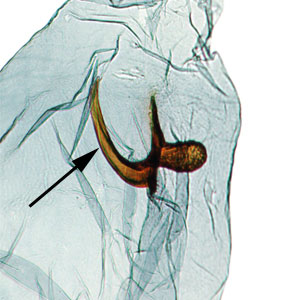 in the corpus bursaecorpus bursae:
in the corpus bursaecorpus bursae:
a dilated membranous sac at the anterior end of the bursa copulatrix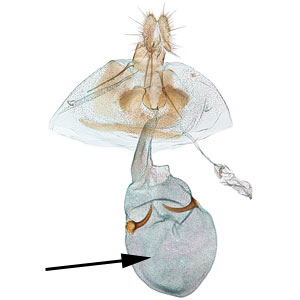 .
.
The following account is summarized from MacKay (1962a).
Mature larva 12-13 mm in length; width of head approximately 0.9 mm. Entire larva pale except for dark ocellar area on head; pinaculapinaculum:
flattened sclerotized plates on a caterpillar that bear the setae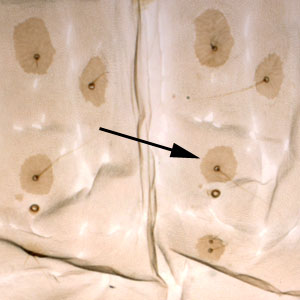 moderate in size; anal shieldanal shield:
moderate in size; anal shieldanal shield:
a sclerotized plate on the dorsal surface of the last abdominal segment (in larvae) 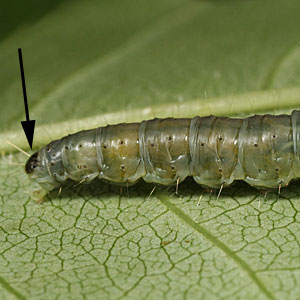 usually slightly tapered posteriorly; SV group on A1, 2, 7, 8, 9 typically 3:3:2:2:2, rarely 3:3:2:2:1.
usually slightly tapered posteriorly; SV group on A1, 2, 7, 8, 9 typically 3:3:2:2:2, rarely 3:3:2:2:1.
Acleris forrskaleana is among the most distinctive of the Acleris which occur in North America. The combination of the pale yellow ground color overlaid with a fine network of orange or red reticulationsreticulations:
covered with a network of lines or mesh; in reference to wing pattern, usually thin horizontal lines  should easily separate it from all other species of Acleris in our area.
should easily separate it from all other species of Acleris in our area.
The following account is summarized from Kennel (1910)Kennel (1910):
Kennel, J. von. 1910. Die Palaearktischen Tortriciden. Zoologica (Stuttgart) 21. 742 pp. and Ford (1949)Ford (1949):
Ford, L. T. 1949. A guide to the smaller British Lepidoptera. South London Entomological and Natural History Society, London, England. 230 pp..
In Europe, larvae occur from May to June, pupae from June to July, and adults from the end of June to mid August. The phenology in North America is similar (Powell & Burns 1971). Overwintering likely occurs in the egg stage, but this requires confirmation. Little else is known about the life cycle for A. forsskaleana.
Maple (Acer spp.) appears to be the exclusive host plant for A. forsskaleana. Early instars are leaf-webbers; later instars are leaf-rollers. The record of Rosa centifolia by Kennel (1910)Kennel (1910):
Kennel, J. von. 1910. Die Palaearktischen Tortriciden. Zoologica (Stuttgart) 21. 742 pp. is almost definitely based on a misidentification of a similar species, Acleris bergmanniana. Ford (1949)Ford (1949):
Ford, L. T. 1949. A guide to the smaller British Lepidoptera. South London Entomological and Natural History Society, London, England. 230 pp. includes “sycamore”, but was likely referring to Acer pseudoplatanus, known in Europe as sycamore, but in the United States as sycamore maple.
| Host plant | Host plant family | Reference(s) |
| Acer campestre | Aceraceae | Bradley et al. 1973Bradley et al. 1973: Bradley, J. D., Tremewan, W. G., Smith, A. 1973. British Tortricoid Moths, Cochylidae and Tortricidae: Tortricinae. The Ray Society, London. 251 pp.; Emmet 1992Emmet 1992: Emmet, A.M. 1992. Life history and habits of the British Lepidoptera. Pp. 61-300. In : Emmet, A.M., Heath, J. (eds.), The Moths and Butterflies of Great Britain and Ireland, 7. 400 pp., Harley Books, Colchester. |
| Acer pseudoplatanus | Aceraceae | Bradley et al. 1973Bradley et al. 1973: Bradley, J. D., Tremewan, W. G., Smith, A. 1973. British Tortricoid Moths, Cochylidae and Tortricidae: Tortricinae. The Ray Society, London. 251 pp.; Emmet 1992Emmet 1992: Emmet, A.M. 1992. Life history and habits of the British Lepidoptera. Pp. 61-300. In : Emmet, A.M., Heath, J. (eds.), The Moths and Butterflies of Great Britain and Ireland, 7. 400 pp., Harley Books, Colchester. |
| Acer sp. | Aceraceae | Meyrick MS 1938Meyrick MS 1938: Meyrick MS 1938. Unpublished manuscript by E. Meyrick at BMNH, data captured by Gaeden Robinson.; MacKay 1962aMacKay 1962a: MacKay, M. R. 1962a. Larvae of the North American Tortricinae (Lepidoptera: Tortricidae). Canadian Entomologist, Supplement 28: 1-182. |
View full screen host table here
In its native range, A. forsskaleana is broadly distributed in Europe, from the United Kingdom and Spain east to Russia. It has been recorded from Iran (Alipanah 2009Alipanah 2009:
Alipanah, H. 2009. A brief study on the tribes Tortricini and Archipini (Lepidoptera: Tortricinae) from Iran. Entomofauna. 30(10): 137-151.), but it is unclear whether this represents an extension of its known native range or a result of an introduction. It was introduced into North America, where the earliest record is from Long Island in 1932 (Powell & Burns 1971) and has subsequently spread throughout the northeastern United States and neighboring provinces in Canada. A second introduction event later occurred in the Pacific Northwest.